When Title IX was passed 50 years ago, there wasn’t a single mention of “sports” or “athletics” anywhere in the bill. The focus was on prohibiting sex-based discrimination and leveling the playing field for girls and women in education, but it didn’t take long for those protections to literally be taken to the field.
Without Title IX, it’s difficult to imagine that women’s sports would be what they are today. From the youth level to college to professional, the success of girl and women athletes today can all be directly tied to a law passed in 1972. Though there is still progress to be made, here are the moments that have defined the growth of women’s sports.
NOV. 3, 1964
Patsy Mink (D., Hawai‘i) becomes the first woman of color and first Asian American elected to the U.S. House of Representatives. She goes on to be the primary author and sponsor of Title IX, alongside Rep. Edith Green (D., Ore.) and Sen. Birch Bayh (D., Ind.).
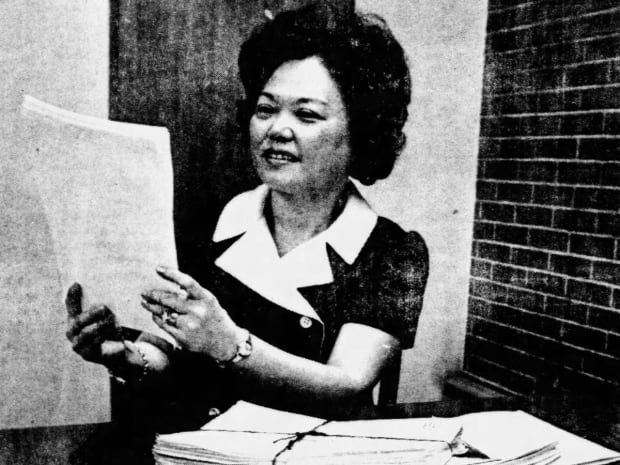
Statesman Journal/USA Today Network
OCT. 13, 1967
President Lyndon B. Johnson signs Executive Order 11375, which prohibits federal contractors from employment practices that discriminate on the basis of sex, laying the groundwork for future gender-equity legislation.
1969–72
Dr. Bernice Sandler, often referred to as the “Godmother of Title IX,” volunteers for the Women’s Equity Action League, where she works to enforce President Johnson’s executive order, documenting data and filing 250 complaints, as well as a class-action lawsuit against all universities in the U.S. She also writes the first federal policy report on education relating to gender discrimination and does important advocacy work as part of the House’s Subcommittee on Education.
JUNE 23, 1972
President Richard Nixon signs into law Title IX of the Education Amendments Act, which is enacted by Congress and prohibits discrimination on the basis of sex for all educational programs or activities that receive funding from the federal government. Though it’s now most closely associated with gender equity in sports, Title IX does not initially explicitly mention athletics.
APRIL 17, 1972
The first official women’s field at the Boston Marathon includes eight women. This happens six years after Roberta “Bobbi” Gibb secretly becomes the first woman to complete the race, running without an official bib number, and five years after Kathrine Switzer manages to get a bib number and finishes the marathon despite an attempt by officials to physically push her out mid-race.
SEPT. 20, 1973
Two years after becoming the first woman athlete to earn $100,000 in any sport in one season, Billie Jean King wins the highly publicized Battle of the Sexes tennis match against Bobby Riggs. A year later, King starts the Women’s Sports Foundation, one of the first steps in her longtime advocacy to protect the foundation of Title IX and its application in sports.

Tony Triolo/Sports Illustrated
MAY 20, 1974
Texas Senator John Tower sponsors an amendment that would exempt revenue sports from Title IX compliance, but it fails to pass in the House. Not long after, Sen. Jacob Javits (R., N.Y.) submits an amendment arguing that expenditure matching can be exempted for revenue-producing sports of a certain nature, like those with larger audiences or more expensive equipment.
MAY 27, 1975
President Gerald Ford signs the final version of Title IX legislation. It includes Javits’s proposal and is submitted for congressional approval.
JULY 21, 1975
The Department of Health, Education and Welfare issues federal regulations regarding Title IX compliance within athletics. High schools and colleges that receive federal funds are given three years to comply, while elementary schools are given one.
FEB. 17, 1976
The NCAA files a lawsuit challenging the legality of Title IX, claiming that no athletic programs receive direct federal funds, but the suit is dismissed.
SEPT. 1976
Ann Meyers becomes the first woman to receive a four-year athletic scholarship when she enrolls at UCLA to play basketball. Three years later, she continues making history as the first woman to sign an NBA contract, with the Pacers.
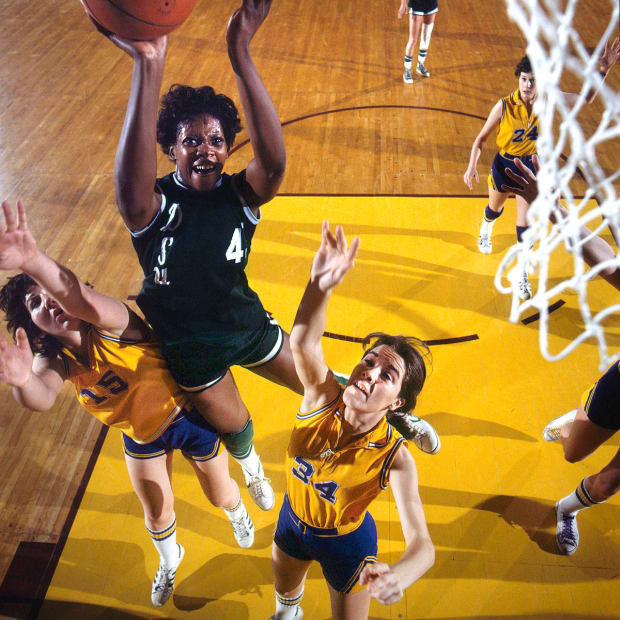
John G. Zimmerman/Sports Illustrated
DEC. 11, 1979
The Office for Civil Rights issues a policy interpretation known as the three-prong test that outlines the ways an institution can prove it is in compliance with Title IX: the percentage of women athletes is significantly proportionate to enrollment rates, opportunities for women athletes are steadily expanding, and the interests and skills of women students in athletics are being accommodated.
MAY 4, 1980
The U.S. Department of Education begins operating after its creation a year earlier and is given oversight of Title IX through the Office for Civil Rights.
SEPT. 22, 1980
After Alexander v. Yale is brought to court by five Yale College women, the court sets a precedent that an educational institution’s lack of system for handling sexual harassment charges could be considered sexual discrimination and was therefore covered by Title IX. This led Yale to create a structured procedure for managing sexual harassment complaints and kickstarted the similar processes among other higher education institutions.
JAN. 12, 1981
The NCAA passes legislation to create women’s Division I national championships. Within the next year, D-I national champions are crowned for the first time in women’s cross-country, field hockey, volleyball, swimming, basketball, golf, gymnastics, tennis, outdoor track and softball.
FEB. 28, 1984
The Supreme Court rules in Grove City College v. Bell that Title IX applies only to programs that receive direct federal funding, thus limiting the scope of the law and taking away its application to athletics (beyond scholarships).
MARCH 22, 1988
Congress overrides a veto by President Ronald Reagan and passes the Civil Rights Restoration Act, which reverses the Supreme Court’s ruling in Grove City College v. Bell. The law reinstates Title IX’s coverage of athletics by asserting that any institution receiving federal funds (for any program or activity) must comply with Title IX in all its programs and activities.
NOV. 30, 1991
The first FIFA Women’s World Cup is held. The U.S. wins with a roster of current and former NCAA athletes.

Tommy Cheng/AFP/Getty Images
FEB. 26, 1992
In Franklin v. Gwinnett County Public Schools, the Supreme Court holds that plaintiffs may sue for monetary damages under Title IX after a district court dismissed the suit. After the ruling, there’s a decrease in complaints to enforcement agencies over Title IX violations and an increase in lawsuits.
MARCH 11, 1992
The first gender equity study done by the NCAA finds significant discrepancies in participation rates, funding and salary for men and women within athletic programs. The NCAA also forms the Gender-Equity Task Force, which disbands soon after it releases its first report (and does not reconvene until 2015).
JUNE 24, 1993
Howard basketball coach Sanya Tyler sues the university for sex discrimination under Title IX, arguing she was paid much less than her men’s basketball counterpart and that the women’s team received fewer resources. She is granted the first monetary award given by a jury in a Title IX case: $2.4 million (later reduced to $250,000). Seven years later, she sues the university again with the claim that her eventual firing is a breach of contract.
APRIL 16, 1993
Amy Cohen files a class-action lawsuit against Brown University (on behalf of all present, future and past women athletes at the school) after two women’s teams were demoted in an attempt to cut costs across the university. In Cohen v. Brown, the court finds that the school does not meet any of the requirements for Title IX’s three-prong test. The university is ordered to reinstate the previously cut programs, and the case establishes a precedent for how athletic departments manage participation opportunities.
SEPT. 1, 1994
Men from the University of Illinois’s swim team, which had been terminated the year before, bring forth the first Title IX case against a university alleging gender discrimination against men. This case set a precedent that men may not use Title IX to claim sex discrimination when their programs are cut for financial reasons (because men’s participation in athletics is still more than proportionate to their enrollment, and their interests and abilities are met—which is not the case for women’s teams).
OCT. 20, 1994
Congress passes the Equity in Athletics Disclosure Act, sponsored by Sen. Carol Moseley Braun and Rep. Cardiss Collins, both of Illinois. It requires universities and colleges to create annual reports on gender equity within their athletics programs and make them available to the general public (upon request), as well as submit them to the federal government.
JAN. 16, 1996
In response to growing concern that schools are cutting men’s programs to reach proportionality, the Office for Civil Rights issues guidelines clarifying the three-prong test introduced in ’79. It says that institutions can choose which of the three conditions they plan to meet and elaborates on how Title IX requires the OCR to count participation opportunities.
APRIL 24, 1996
The Women’s National Basketball Association is approved by the NBA Board of Governors, with the inaugural season tipping off in June ’97. Val Ackerman is the founding president of the league, and she later becomes the first woman president of USA Basketball in 2005.
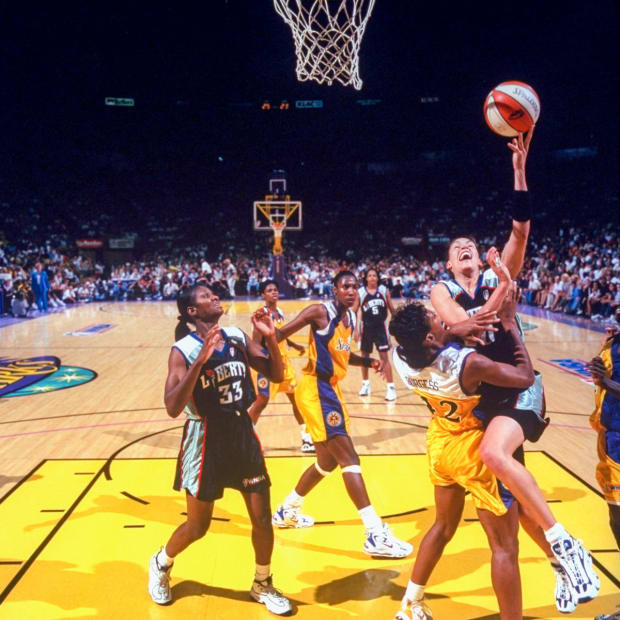
John W. McDonough/Sports Illustrated
FEB. 20, 2001
The Supreme Court issues a decision in Brentwood v. Tennessee Secondary School Athletic Association, holding that a high school athletic association is a “state actor,” so it can be held to constitutional standards for civil rights purposes and gender equity suits.
MARCH 17, 2005
The Department of Education issues a policy clarification stating that schools may survey women students’ interest in sports via email, meaning institutions can take a failure to respond as indication of a lack of interest. Title IX supporters say this will inhibit schools from achieving gender equity, and it is later rescinded by the Obama Administration.
APRIL 4, 2011
The Department of Education issues a “Dear Colleague” policy guidance that makes clear that Title IX’s protections against sexual harassment and sexual violence apply to all students, including athletes. It points to athletics departments in its requirement that schools use the same procedures to resolve sexual violence complaints for all students.
AUG. 3, 2011
In a lawsuit that began 10 years earlier, three women wrestlers who were cut from the team at UC Davis claim that the university discriminated against them on the basis of gender by forcing them to try out against the men. A federal court agrees that the university failed to provide sufficient athletic opportunities for women, but holds that the university officials listed as defendants did not deliberately discriminate. UC Davis settled with the women months later, paying more than $1.3 million.
JUNE 23, 2012
On the 40th anniversary of Title IX’s passage, the number of girls participating in high school sports nationwide has risen tenfold, to more than 3 million. The NCAA issues a special report for the anniversary and finds that in the 2009–10 school year, women (who made up 53% of students) still received less than half of the total athletic scholarship dollars at Division I schools and only 40% of the total money spent on athletics.
MAY 13, 2016
The Department of Education and the Department of Justice issue a joint “Dear Colleague” letter, which contains guidance on protecting transgender students under Title IX. It outlines that gender discrimination includes any that is based on a student’s gender identity and states that schools are required to treat transgender students—with regards to complying with Title IX, implementing regulations or providing sex-segregated activities and facilites— in a manner that is consistent with their gender identity.
FEB. 22, 2017
After a rise in litigation regarding school restrooms, OCR rescinds Title IX guidance on transgender students issued the year before to further consider the legal issues involved.
AUG. 14, 2020
Secretary of Education Betsy DeVos enacts controversial changes to Title IX that give more rights to those accused of sexual assault and harassment, narrow the definition of sexual misconduct on college campuses and raise the standard of proof available for schools to use in the cases.
DEC. 12, 2020
Sarah Fuller becomes the first woman to score in a Power 5 conference football game as the goalkeeper for the Commodores’ women’s soccer team (SEC champions at the time) kicks a pair of extra points for Vanderbilt in its game against Tennessee.
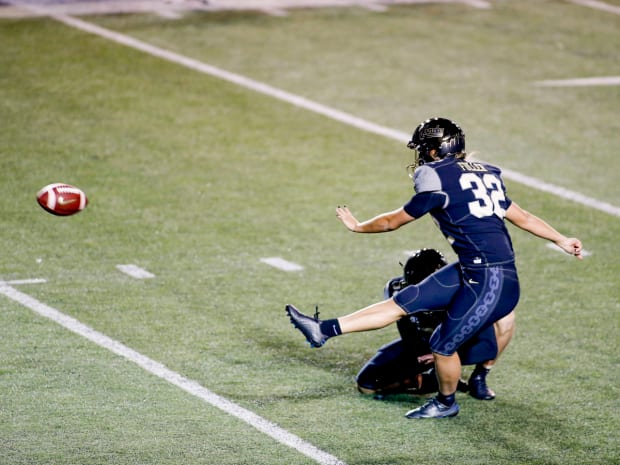
Matthew Maxey/Icon Sportswire/Getty Images
JAN. 20, 2021
On his first day in office, President Joe Biden signs an executive order stating that all people should receive equal treatment under the law no matter their gender identity or sexual orientation. It also directs all federal agencies to implement this same nondiscrimination policy and review any and all actions to ensure anything prohibiting discrimination on the basis of gender or sex also includes discrimination based on sexual orientation and gender identity.
MARCH 8, 2021
President Biden releases another executive order that guarantees an educational environment free from discrimination on the basis of sex, gender identity or sexual orientation. It cites Title IX as an applicable governing law in its attempt to address the discrimination and harassment LGBTQ students face at school.
MAY 18, 2021
As part of a wave of lawsuits filed in response to colleges cutting athletic programs due to financial pressures during the COVID-19 pandemic, the Clemson men’s track and field and cross-country teams win an unprecedented settlement when they successfully leverage Title IX to have the men’s teams reinstated.
JUNE 28, 2021
The Supreme Court declines to hear an appeal from Grimm v. Gloucester County School Board, leaving in place a lower court’s ruling that the Virginia school board’s attempt to bar Gavin Grimm from using the men’s bathroom violated Title IX and the Constitution. The Supreme Court had taken the case back in 2016 but dismissed it the next year after the Trump administration released a new federal position on transgender rights.
FEB. 22, 2022
The U.S. women’s national soccer team reaches a proposed settlement in its class action equal pay lawsuit after a six-year legal battle. The athletes receive $24 million (most of which is to make up for the fact that pay has been unequal for years) while the U.S. Soccer Federation pledges to equalize pay between the men’s and women’s national teams in all competitions—even the World Cup.
MARCH 14, 2022
Reps. Carolyn Maloney (D., N.Y.), Jackie Speier (D., Calif.) and Mikie Sherrill (D., N.Y.) pen a letter to NCAA president Mark Emmert to criticize the organization’s failure to make progress on gender equity after the ’21 NCAA basketball tournaments highlighted the gap in treatment of the men’s and women’s teams. Their letter suggests the NCAA may be in violation of Title IX.
MARCH 17, 2022
Lia Thomas becomes the first known transgender woman to win a Division I title when she finishes first in the 500-yard freestyle at the NCAA swimming and diving championship. Her dominance in the sport raises questions from conservative groups surrounding Title IX and fair participation opportunities for women.
MARCH 22, 2022
The ’22 NCAA women’s basketball tournament breaks a nearly two-decade-old attendance record, with 216,890 fans attending the first two rounds.
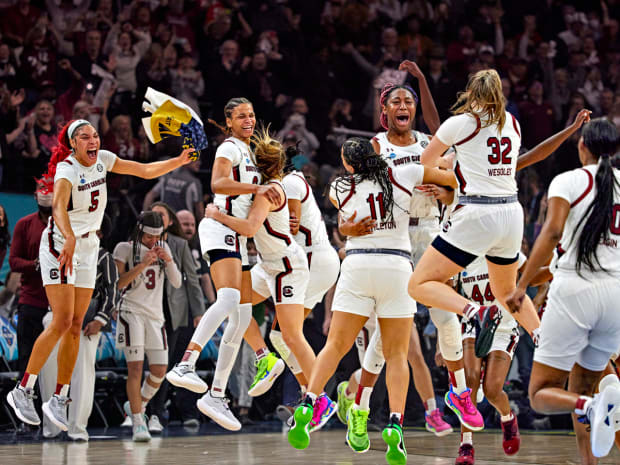
David E. Klutho/Sports Illustrated
APRIL 3, 2022
The NCAA women’s basketball championship between No. 1 South Carolina and No. 2 Connecticut sets a record for the most-watched college basketball game on ESPN in more than a decade, dating back to ’08. The game totaled 4.85 million viewers, with audience numbers peaking at nearly 6 million.







